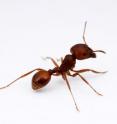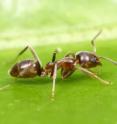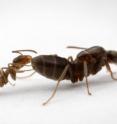Newly decoded ant genomes provide clues on ant social life, pest control
Related images
(click to enlarge)
Scientists have deciphered the genome of a persistent household pest -- the Argentine ant, an invasive species that is threatening native insects across the world. The newly sequenced genomes of the Argentine ant (Linepithema humile) and the red harvester ant (Pogonomyrmex barbatus) could provide new insights on how embryos with the same genetic code develop into either queens or worker ants and may advance our understanding of invasion biology and pest control. An international collaboration of scientists reported the results today as part of a series of three decoded ant genomes, including the Argentine ant, the red harvester ant and the fire ant published in the Proceedings of the National Academy of Sciences. In addition, the genome of the leaf‑cutter ant is scheduled for publication in the Feb. 24 issue of the Public Library of Science Genetics. See below for high-res images and how to obtain copies of the papers. "We now know that ants have the genes and genome signature of DNA methylation -- the same molecular mechanism that published honeybee studies have shown is responsible for switching whether the genome is read to be a worker or queen," said Christopher D. Smith, assistant professor of biology at San Francisco State University, an author on three of the four genome studies.
Similar to bees, ants have sophisticated social structures. Queen ants typically have larger bodies, wings and fertile ovaries, and are responsible for reproduction in the colony. Worker ants are smaller, wingless and infertile, and are tasked with foraging for food and caring for the queen's offspring.
Analysis of these new ant genomes suggests that chemical modification of certain sections of DNA could be responsible for the differential development of queens and workers. As an ant larva develops, DNA methylation, which involves methyl chemical groups attaching onto the DNA, may switch off the genes that control reproductive capacity and wing growth.
"Our analysis suggests that ants may utilize the same genetic system as honeybees to create their social structures, although we have yet to understand whether the process works in exactly the same way across species," Smith said.
Smith co-led the Argentine ant research with Neil Tsutsui of University of California, Berkeley; was a lead author on the red harvester ant genome along with Chris R. Smith of Earlham College and Jürgen Gadau of Arizona State University; and was a co-author on the leaf-cutter ant genome.
Argentine ants
The mapping of the Argentine ant genome may enable the development of novel pest control solutions. A better understanding of how larvae develop into queens or workers could support the development of new control methods that use more benign chemicals to limit the number of queens born in a colony, effectively sterilizing the population.
Tiny, brown Argentine ants have spread to nearly every Mediterranean-type climate in the world in the last century, where they are threatening and eradicating native species and disrupting agriculture by protecting aphids that attack crops. In their native South America, aggression between Argentine ants from different nests keeps their population in check, but beyond their native range, they do not attack ants from other nests, which has allowed them to form massive "supercolonies".
"The Argentine ant genome provides a reference map that may help us understand the geography and timing of their global invasion, and perhaps how they've evolved to increase insecticide resistance," Smith said.
Red harvester ants
Analysis of the red harvester ant genome suggests these ants have evolved "detox" genes over the course of history, developing a greater number of genes that produce the enzymes needed to digest toxic substances. The researchers explain that this evolution may have taken place 10-30 million years ago in response to the elevation of the Sierra Nevada and Andes mountain ranges, which created deserts on their eastern sides and changed the habitat of ants in the harvester ant genus. New genes related to detoxification may have been an adaptation to new habitats with a changed diet consisting of different seeds and plants.
Red harvester ants are native to the Southwest United States. Their three-tier social structure consists of queen ants, "soldier" ants that work outside the nest and minor workers that stay inside the nest.
Red harvester ants were found to have the largest number of odor detection genes of any known insect, with at least 344 genes related to smell compared to 166 for the honeybee and 225 in the parasitic wasp. Using their antennae to swab surfaces and creatures, ants use their sense of smell for social communication and to detect if nearby insects are friend or foe.
Source: San Francisco State University
Articles on the same topic
- Argentine ant genome sheds light on a successful pestMon, 31 Jan 2011, 20:52:46 UTC
Other sources
- Argentine ant genome sheds light on a successful pestfrom Science DailyTue, 1 Feb 2011, 3:40:21 UTC
- Argentine ant genome sheds light on a successful pestfrom PhysorgMon, 31 Jan 2011, 20:51:29 UTC


